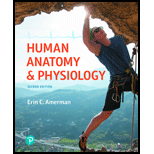
EP HUMAN ANATOMY+PHYSIOLOGY-MOD.MASTER.
2nd Edition
ISBN: 9780134788067
Author: AMERMAN
Publisher: PEARSON CO
expand_more
expand_more
format_list_bulleted
Textbook Question
thumb_up100%
Chapter 1.3, Problem 2QC
Fill in the blanks:
The nose is to the mouth.
The ankle is to the knee.
The ring finger is to the index finger.
The skin is to the bone.
The trachea is to the spine.
The shoulder is to the wrist.
Expert Solution & Answer
Learn your wayIncludes step-by-step video

schedule04:47
Students have asked these similar questions
4. This question focuses on entrainment.
a. What is entrainment?
b. What environmental cues are involved in entrainment, and which one is most influential?
c. Why is entrainment necessary?
d. Assuming that a flash of darkness is an effective zeitgeber, what impact on circadian
rhythms would you expect to result from an event such as the 2024 solar eclipse (assume
it was viewed from Carbondale IL, where totality occurred at about 2 pm)? Explain your
reasoning. You may wish to consult this phase response diagram.
Phase Shift (Hours)
Delay Zone
Advance Zone
Dawn
Mid-day
Dusk
Night
Dawn
Time of Light Stimulus
e. Finally, give a real-world example of how knowledge of circadian rhythms and
entrainment has implications for human health and wellbeing or conservation biology.
This example could be from your reading or from things discussed in class.
Generate one question that requires a Punnet Squre to solve the question. Then show how you calculate the possibilities of genotype and phenotype
Briefly state the physical meaning of the electrocapillary equation (Lippman equation).
Chapter 1 Solutions
EP HUMAN ANATOMY+PHYSIOLOGY-MOD.MASTER.
Ch. 1.1 - What are some examples of learning modalities?Ch. 1.1 - 2. How should you approach reading a textbook,...Ch. 1.1 - What are some study strategies to improve your...Ch. 1.1 - Prob. 4QCCh. 1.1 - 5. What are some strategies for taking good notes...Ch. 1.1 - 6. How can you use the features found in each...Ch. 1.1 - 7. How should you approach the study of figures...Ch. 1.2 - What are the properties common to all living...Ch. 1.2 - Prob. 2QCCh. 1.2 - 3. What are the 11 organ systems in the body?
Ch. 1.2 - 4. How do gross anatomy and microscopic anatomy...Ch. 1.2 - How are physiological specializations classified?Ch. 1.3 - What is anatomical position?Ch. 1.3 - Fill in the blanks: The nose is to the mouth....Ch. 1.3 - Fill in the blanks: a. The wrist is also known as...Ch. 1.3 - How do the three main planes of section differ?Ch. 1.4 - What are the two subcavities of the posterior body...Ch. 1.4 - 2. List the subdivisions of the thoracic and...Ch. 1.4 - 3. What are serous membranes, and what are their...Ch. 1.4 - Explain how serous membranes form certain anterior...Ch. 1.5 - 1. What is homeostasis, and why is it important?
Ch. 1.5 - 2. What is a homeostatic imbalance?
Ch. 1.5 - How do negative feedback loops maintain...Ch. 1.5 - Prob. 4QCCh. 1.5 - Prob. 5QCCh. 1.5 - What is a gradient? What are some examples of...Ch. 1.5 - 7. Why is cell-cell communication important?
Ch. 1.5 - 8. What are the two major methods by which cells...Ch. 1 - Fill in the blanks: The study of the form of the...Ch. 1 - Mark the following statements as true or false. If...Ch. 1 - Prob. 3CYRCh. 1 - Prob. 4CYRCh. 1 - 5. Which of the following correctly describes the...Ch. 1 - Mark the following statements as true or false. If...Ch. 1 - Match the following terms with the correct...Ch. 1 - 8. The upper and lower limbs are known broadly as...Ch. 1 - The arm is known as the ___________ region; the...Ch. 1 - A parasagittal section divides the body or body...Ch. 1 - 11. Fill in the blanks: The two divisions of the...Ch. 1 - 12. Fill in the blanks: The two main divisions of...Ch. 1 - 13. In which of the following cavities do serous...Ch. 1 - 14. Serous fluid functions in:
a. Providing...Ch. 1 - 15. Which organs would you expect to find in the...Ch. 1 - 16. Mark the following statements as true or...Ch. 1 - Prob. 17CYRCh. 1 - Examine the structure of the skull, and predict...Ch. 1 - Prob. 2CYUCh. 1 - Prob. 1AYKCh. 1 - 2. During a procedure on Ms. Norman’s pancreas, a...Ch. 1 - Later that same day, the surgeon performs a...Ch. 1 - The baroreceptor reflex causes blood pressure to...
Additional Science Textbook Solutions
Find more solutions based on key concepts
Police Captain Jeffers has suffered a myocardial infarction. a. Explain to his (nonmedically oriented) family w...
Human Physiology: An Integrated Approach (8th Edition)
The bioremediation process shown in the photograph is used to remove benzene and other hydrocarbons from soil c...
Microbiology: An Introduction
APPLY 1.2 Express the following quantities in scientific notation
using fundamental SI units of mass and lengt...
Chemistry (7th Edition)
1.3 Obtain a bottle of multivitamins and read the list of ingredients. What are four chemicals from the list?
Chemistry: An Introduction to General, Organic, and Biological Chemistry (13th Edition)
5.4 Genes E and H are syntenic in an experimental organism with the genotype . Assume
that during each meiosis,...
Genetic Analysis: An Integrated Approach (3rd Edition)
All of the following processes are involved in the carbon cycle except: a. photosynthesis b. cell respiration c...
Human Biology: Concepts and Current Issues (8th Edition)
Knowledge Booster
Learn more about
Need a deep-dive on the concept behind this application? Look no further. Learn more about this topic, biology and related others by exploring similar questions and additional content below.Similar questions
- Explain in a small summary how: What genetic information can be obtained from a Punnet square? What genetic information cannot be determined from a Punnet square? Why might a Punnet Square be beneficial to understanding genetics/inheritance?arrow_forwardIn a small summary write down:arrow_forwardNot part of a graded assignment, from a past midtermarrow_forward
- Noggin mutation: The mouse, one of the phenotypic consequences of Noggin mutationis mispatterning of the spinal cord, in the posterior region of the mouse embryo, suchthat in the hindlimb region the more ventral fates are lost, and the dorsal Pax3 domain isexpanded. (this experiment is not in the lectures).a. Hypothesis for why: What would be your hypothesis for why the ventral fatesare lost and dorsal fates expanded? Include in your answer the words notochord,BMP, SHH and either (or both of) surface ectoderm or lateral plate mesodermarrow_forwardNot part of a graded assignment, from a past midtermarrow_forwardNot part of a graded assignment, from a past midtermarrow_forward
arrow_back_ios
SEE MORE QUESTIONS
arrow_forward_ios
Recommended textbooks for you
 Fundamentals of Sectional Anatomy: An Imaging App...BiologyISBN:9781133960867Author:Denise L. LazoPublisher:Cengage LearningLifetime Physical Fitness & WellnessHealth & NutritionISBN:9781337677509Author:HOEGERPublisher:Cengage
Fundamentals of Sectional Anatomy: An Imaging App...BiologyISBN:9781133960867Author:Denise L. LazoPublisher:Cengage LearningLifetime Physical Fitness & WellnessHealth & NutritionISBN:9781337677509Author:HOEGERPublisher:Cengage Medical Terminology for Health Professions, Spira...Health & NutritionISBN:9781305634350Author:Ann Ehrlich, Carol L. Schroeder, Laura Ehrlich, Katrina A. SchroederPublisher:Cengage Learning
Medical Terminology for Health Professions, Spira...Health & NutritionISBN:9781305634350Author:Ann Ehrlich, Carol L. Schroeder, Laura Ehrlich, Katrina A. SchroederPublisher:Cengage Learning Nutrition Through the Life Cycle (MindTap Course ...Health & NutritionISBN:9781305628007Author:Judith E. BrownPublisher:Cengage Learning
Nutrition Through the Life Cycle (MindTap Course ...Health & NutritionISBN:9781305628007Author:Judith E. BrownPublisher:Cengage Learning

Fundamentals of Sectional Anatomy: An Imaging App...
Biology
ISBN:9781133960867
Author:Denise L. Lazo
Publisher:Cengage Learning


Lifetime Physical Fitness & Wellness
Health & Nutrition
ISBN:9781337677509
Author:HOEGER
Publisher:Cengage

Medical Terminology for Health Professions, Spira...
Health & Nutrition
ISBN:9781305634350
Author:Ann Ehrlich, Carol L. Schroeder, Laura Ehrlich, Katrina A. Schroeder
Publisher:Cengage Learning

Nutrition Through the Life Cycle (MindTap Course ...
Health & Nutrition
ISBN:9781305628007
Author:Judith E. Brown
Publisher:Cengage Learning

The Skeletal System; Author: Professor Dave Explains;https://www.youtube.com/watch?v=f-FF7Qigd3U;License: Standard YouTube License, CC-BY